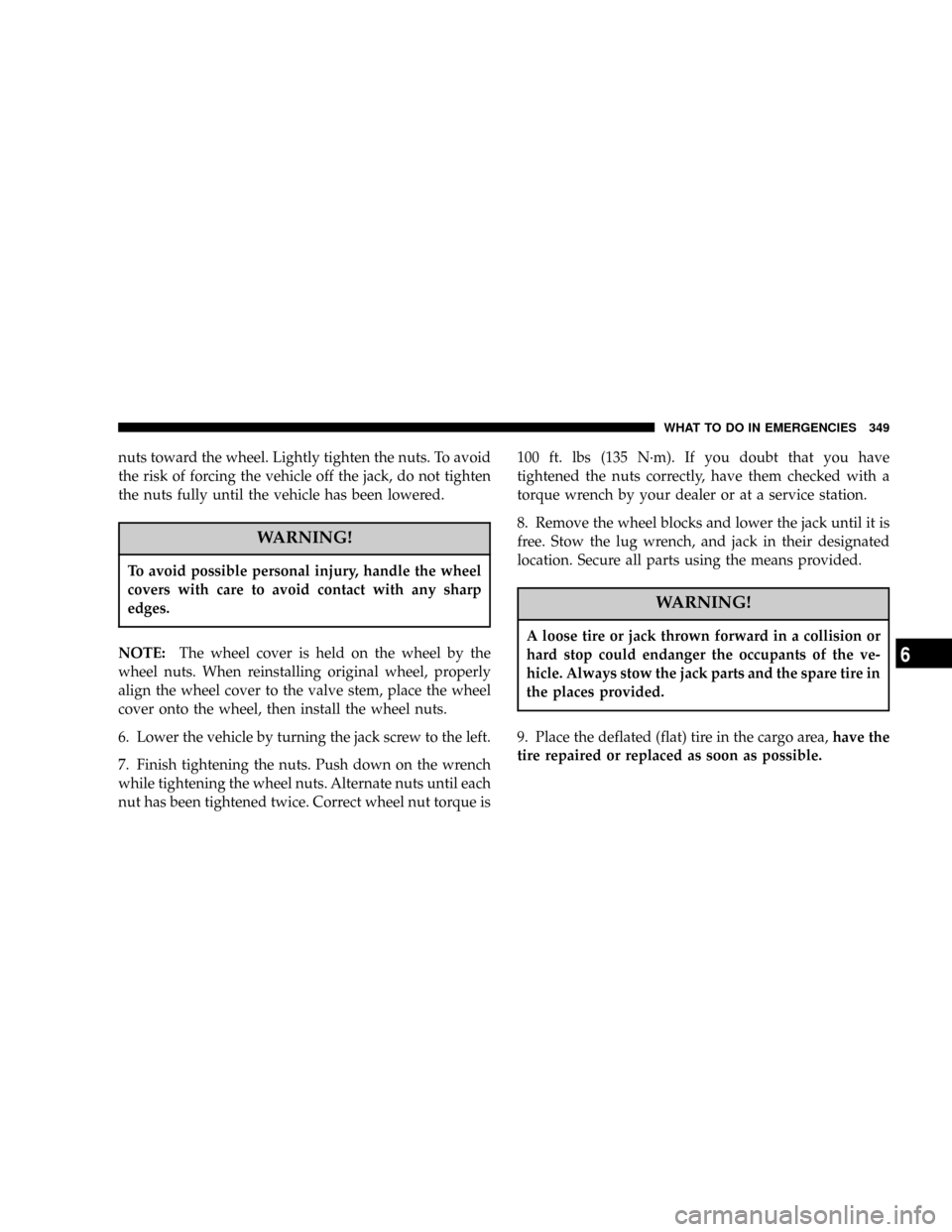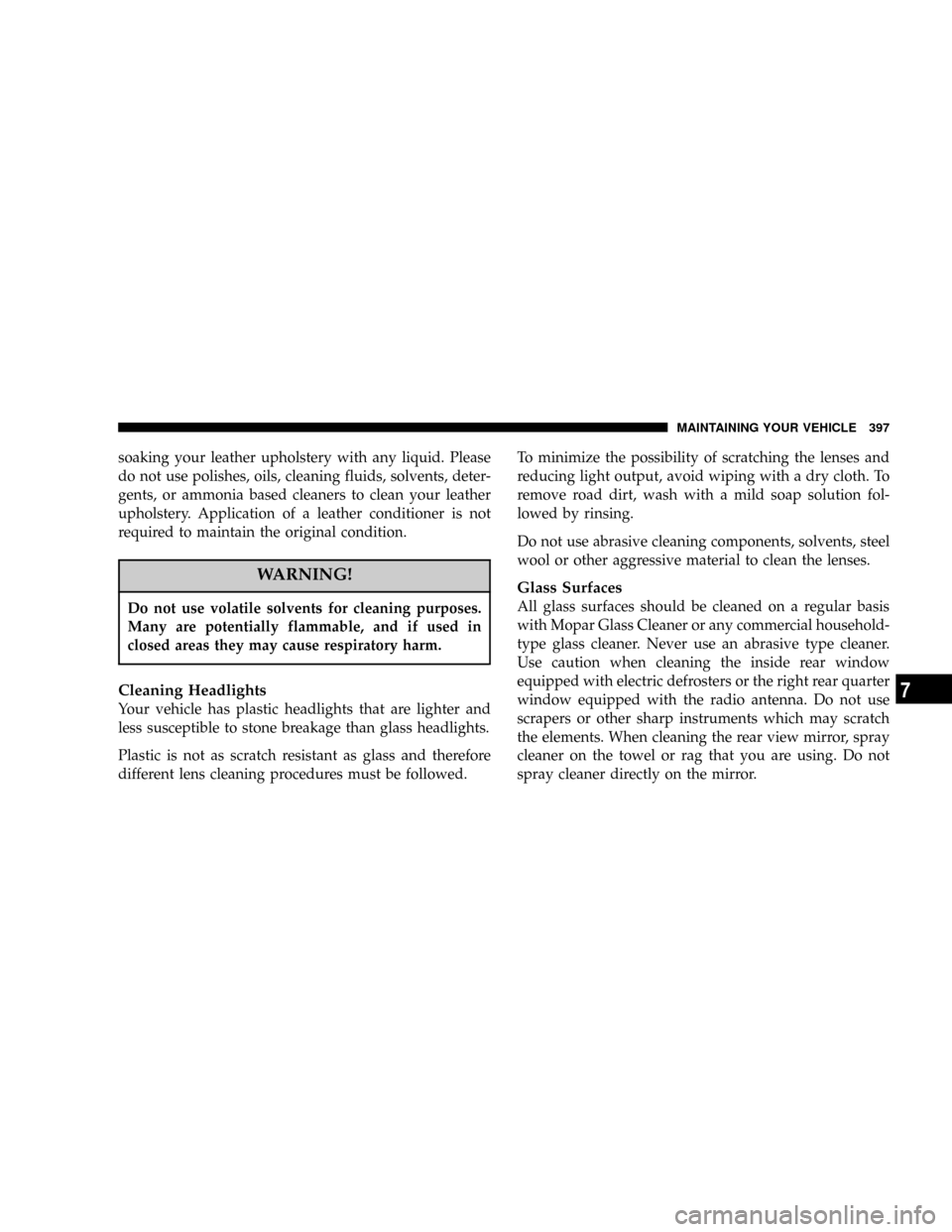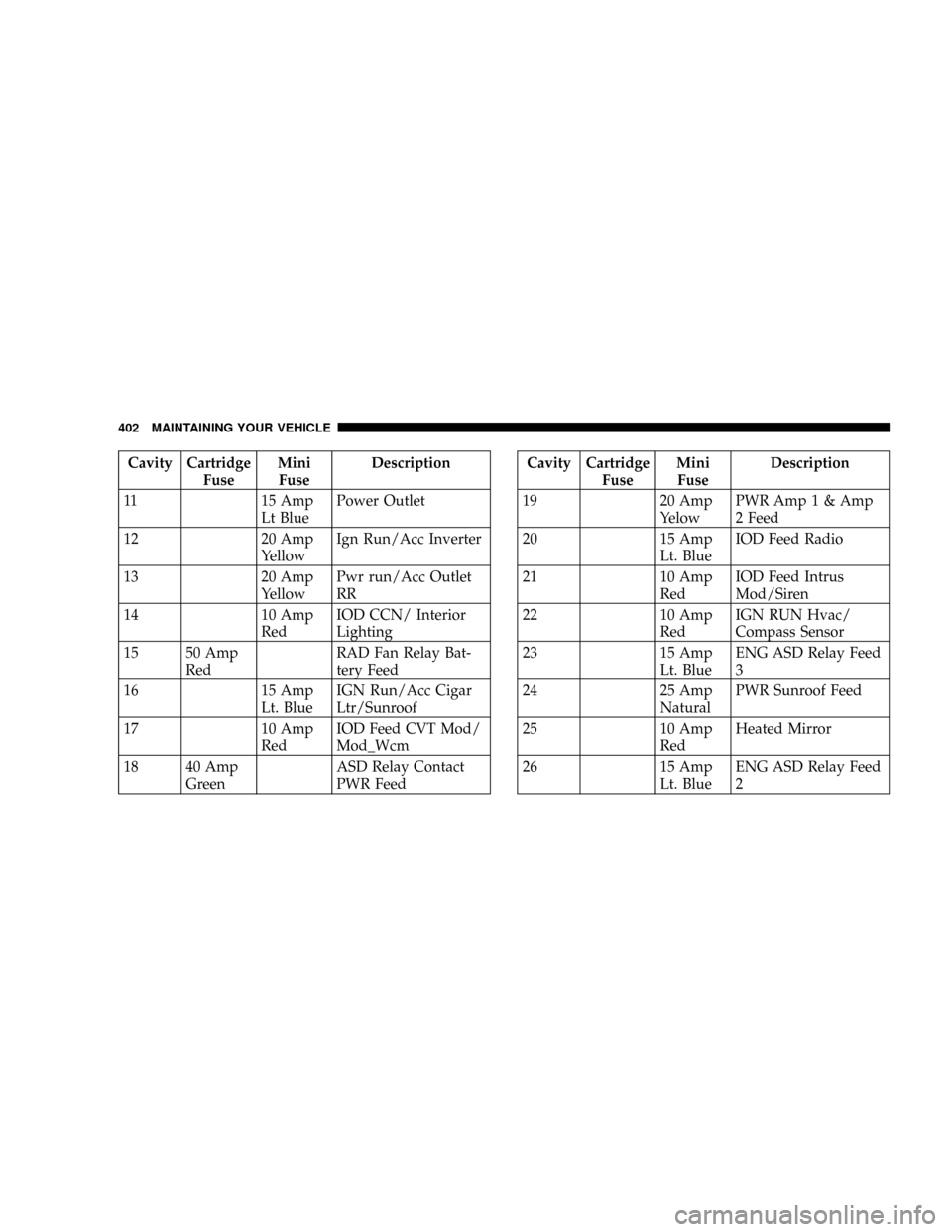light CHRYSLER PT CRUISER 2007 1.G Owners Manual
[x] Cancel search | Manufacturer: CHRYSLER, Model Year: 2007, Model line: PT CRUISER, Model: CHRYSLER PT CRUISER 2007 1.GPages: 467, PDF Size: 7.57 MB
Page 340 of 467

Towing Tips Ð Electronic Speed Control (If
Equipped)
þ
Don't use in hilly terrain or with heavy loads.
þWhen using the speed control, if you experience speed
drops greater than 10 mph (16 km/h), disengage until
you can get back to cruising speed.
þUse speed control in flat terrain and with light loads to
maximize fuel efficiency.
Towing Tips Ð Cooling System
To reduce potential for engine and transmission over-
heating, take the following actions:
þCity Driving
When stopped for short periods of time, put transmission
in neutral but do not increase engine idle speed.
þHighway Driving
Reduce speed.
þAir Conditioning
Turn off temporarily.
þrefer to Cooling System Operating information in the
Maintenance section of this manual for more informa-
tion.
RECREATIONAL TOWING (BEHIND
MOTORHOME, ETC.)
Towing This Vehicle Behind Another Vehicle (Flat
towing with all four wheels on the ground)
Recreational towing on vehicle's equipped with auto-
matic transaxle's is not recommended.
NOTE:If the vehicle requires towing make sure all four
wheels are off the ground.
If your vehicle is equipped with a manual transaxle, it
may be towed with all four wheels on the ground, in a
forward direction, at any legal highway speed, for any
distance, if the transaxle is in neutral.
340 STARTING AND OPERATING
Page 349 of 467

nuts toward the wheel. Lightly tighten the nuts. To avoid
the risk of forcing the vehicle off the jack, do not tighten
the nuts fully until the vehicle has been lowered.
WARNING!
To avoid possible personal injury, handle the wheel
covers with care to avoid contact with any sharp
edges.
NOTE:The wheel cover is held on the wheel by the
wheel nuts. When reinstalling original wheel, properly
align the wheel cover to the valve stem, place the wheel
cover onto the wheel, then install the wheel nuts.
6. Lower the vehicle by turning the jack screw to the left.
7. Finish tightening the nuts. Push down on the wrench
while tightening the wheel nuts. Alternate nuts until each
nut has been tightened twice. Correct wheel nut torque is100 ft. lbs (135 N´m). If you doubt that you have
tightened the nuts correctly, have them checked with a
torque wrench by your dealer or at a service station.
8. Remove the wheel blocks and lower the jack until it is
free. Stow the lug wrench, and jack in their designated
location. Secure all parts using the means provided.
WARNING!
A loose tire or jack thrown forward in a collision or
hard stop could endanger the occupants of the ve-
hicle. Always stow the jack parts and the spare tire in
the places provided.
9. Place the deflated (flat) tire in the cargo area,have the
tire repaired or replaced as soon as possible.
WHAT TO DO IN EMERGENCIES 349
6
Page 361 of 467

NHeadlights..........................406
NFront Park/Turn Signal/Side Marker Lights . . 407
NFront Fog Lights Ð If Equipped...........407
NTail/Stop, And Rear Turn Signal Lights......407
NBack Up Lights.......................408NCenter High Mounted Stop Light..........409
mFluids And Capacities...................410
mFluids, Lubricants And Genuine Parts........411
NEngine.............................411
NChassis............................412
MAINTAINING YOUR VEHICLE 361
7
Page 364 of 467

ONBOARD DIAGNOSTIC SYSTEM Ð OBD II
Your vehicle is equipped with a sophisticated onboard
diagnostic system called OBD II. This system monitors
the performance of the emissions, engine, and automatic
transmission control systems. When these systems are
operating properly, your vehicle will provide excellent
performance and fuel economy, as well as engine emis-
sions well within current government regulations.
If any of these systems require service, the OBD II system
will turn on the ªMalfunction Indicator Light.º It will
also store diagnostic codes and other information to
assist your service technician in making repairs. Al-
though your vehicle will usually be drivable and not
need towing, see your dealer for service as soon as
possible.CAUTION!
²Prolonged driving with the ªMalfunction Indica-
tor Lightº on could cause further damage to the
emission control system. It could also affect fuel
economy and driveability. The vehicle must be
serviced before any emissions tests can be per-
formed.
²If the ªMalfunction Indicator Lightº is flashing
while the engine is running, severe catalytic con-
verter damage and power loss will soon occur.
Immediate service is required.
Loose Fuel Filler Cap Message
After fuel is added, the vehicle diagnostic system can
determine if the fuel filler cap is loose, improperly
installed, or damaged. A gASCAP message will be dis-
played in the instrument cluster. Tighten the gas cap until
364 MAINTAINING YOUR VEHICLE
Page 365 of 467

a9clicking9sound is heard. This is an indication that the
gas cap is properly tightened. Press the odometer reset
button to turn the message off. If the problem persists,
the message will appear the next time the vehicle is
started. This might indicate a damaged cap. If the prob-
lem is detected twice in a row, the system will turn on the
Malfunction Indicator Light (MIL). Resolving the prob-
lem will turn the MIL light off.
EMISSIONS INSPECTION AND MAINTENANCE
PROGRAMS
In some localities, it may be a legal requirement to pass
an inspection of your vehicle's emissions control system.
Failure to pass could prevent vehicle registration.
For states, which have an I/M (Inspection and
Maintenance) requirement, this check verifies the
following: the MIL (Malfunction Indicator Light)is functioning and is not on when the engine is running,
and that the OBD (On Board Diagnostic) system is ready
for testing.
Normally, the OBD system will be ready. The OBD
system maynotbe ready if your vehicle was recently
serviced, if you recently had a dead battery, or a battery
replacement. If the OBD system should be determined
not ready for the I/M test, your vehicle may fail the test.
Your vehicle has a simple ignition key actuated test,
which you can use prior to going to the test station. To
check if your vehicle's OBD system is ready, you must do
the following:
1. Insert your ignition key into the ignition switch.
2. Turn the ignition to the ON position, but do not crank
or start the engine.
3. If you crank or start the engine, you will have to start
this test over.
MAINTAINING YOUR VEHICLE 365
7
Page 397 of 467

soaking your leather upholstery with any liquid. Please
do not use polishes, oils, cleaning fluids, solvents, deter-
gents, or ammonia based cleaners to clean your leather
upholstery. Application of a leather conditioner is not
required to maintain the original condition.
WARNING!
Do not use volatile solvents for cleaning purposes.
Many are potentially flammable, and if used in
closed areas they may cause respiratory harm.
Cleaning Headlights
Your vehicle has plastic headlights that are lighter and
less susceptible to stone breakage than glass headlights.
Plastic is not as scratch resistant as glass and therefore
different lens cleaning procedures must be followed.To minimize the possibility of scratching the lenses and
reducing light output, avoid wiping with a dry cloth. To
remove road dirt, wash with a mild soap solution fol-
lowed by rinsing.
Do not use abrasive cleaning components, solvents, steel
wool or other aggressive material to clean the lenses.
Glass Surfaces
All glass surfaces should be cleaned on a regular basis
with Mopar Glass Cleaner or any commercial household-
type glass cleaner. Never use an abrasive type cleaner.
Use caution when cleaning the inside rear window
equipped with electric defrosters or the right rear quarter
window equipped with the radio antenna. Do not use
scrapers or other sharp instruments which may scratch
the elements. When cleaning the rear view mirror, spray
cleaner on the towel or rag that you are using. Do not
spray cleaner directly on the mirror.
MAINTAINING YOUR VEHICLE 397
7
Page 402 of 467

Cavity Cartridge
FuseMini
FuseDescription
11 15 Amp
Lt BluePower Outlet
12 20 Amp
YellowIgn Run/Acc Inverter
13 20 Amp
YellowPwr run/Acc Outlet
RR
14 10 Amp
RedIOD CCN/ Interior
Lighting
15 50 Amp
RedRAD Fan Relay Bat-
tery Feed
16 15 Amp
Lt. BlueIGN Run/Acc Cigar
Ltr/Sunroof
17 10 Amp
RedIOD Feed CVT Mod/
Mod_Wcm
18 40 Amp
GreenASD Relay Contact
PWR FeedCavity Cartridge
FuseMini
FuseDescription
19 20 Amp
YelowPWR Amp 1 & Amp
2 Feed
20 15 Amp
Lt. BlueIOD Feed Radio
21 10 Amp
RedIOD Feed Intrus
Mod/Siren
22 10 Amp
RedIGN RUN Hvac/
Compass Sensor
23 15 Amp
Lt. BlueENG ASD Relay Feed
3
24 25 Amp
NaturalPWR Sunroof Feed
25 10 Amp
RedHeated Mirror
26 15 Amp
Lt. BlueENG ASD Relay Feed
2
402 MAINTAINING YOUR VEHICLE
Page 405 of 467

REPLACEMENT BULBS
LIGHT BULBS Ð Inside Bulb No.
Center Console Floor Lamp................. T37
Climate Controls......................6233137
Console Gear Selector...................PC194
Dome Light (sedan)......................T579
Dome Light / Sport Bar Lights (convertible)....T904
Instrument Cluster Illumination.............. 74
Overhead Reading Light (Overhead Console). . . T1037
Overhead Reading Light (Rearview Mirror).....T192
Rear Cargo............................T906
Visor Vanity.........................6501966
All the inside bulbs are brass or glass wedge base.
Aluminum base bulbs are not approved and should not
be used for replacement.LIGHTS BULBS Ð Outside Bulb No.
Low Beam Headlight...................9006XS
High Beam Headlight...................9005XS
Front Park/Turn Signal/Side Marker
Light............................4157NAKX
Front Fog Light.........................9145
Center High Mounted Stop Light (CHMSL)
(Sedan)..........................921±W16W
Center High Mounted Stop Light (CHMSL)
(Convertible)........................... LED
Rear Tail/Stop..........................3157
Rear Turn Signal.......................3757A
Backup Light.....................3157-P27/7W
License Light........................... 168
MAINTAINING YOUR VEHICLE 405
7
Page 406 of 467

BULB REPLACEMENT
Headlights
CAUTION!
Do not touch the new headlight bulb with your
fingers. Oil contamination will severely shorten
bulb life.
1. Remove the headlight access cover splash shield,
located in the front wheel well opening.
2. Disconnect the electrical connector.3. Rotate the socket to the left one quarter turn and
replace the bulb.
406 MAINTAINING YOUR VEHICLE
Page 407 of 467

Front Park/Turn Signal/Side Marker Lights
1. Remove the headlight access cover splash shield,
located in the front wheel well opening.
2. Rotate the socket to the left one quarter turn to replace
and replace the bulb.
Front Fog Lights Ð If Equipped
1. Remove the fasteners attaching the lower splash
shield to gain access to the fog light.
2. Twist and remove the bulb from the fog light housing.
3. Disconnect the electrical connector and replace bulb.
Tail/Stop, and Rear Turn Signal Lights
1. Remove the screw attaching the tail light housing and
remove the housing from the vehicle.
MAINTAINING YOUR VEHICLE 407
7